Fertilizing plants in the spring in the garden. Essential trace elements for various crops. What mineral fertilizers to apply to the soil in spring
Fertilizing the garden and garden in spring
In the spring, it is time for active work for summer residents, gardeners and gardeners. To receive you need to good harvest autumn, you need to work hard in the spring. In particular, in the spring it is very important to choose the right fertilizers and apply them to the soil. With all this, it is necessary to take into account the needs of the crops that will be grown on the site.
Fertilizing the garden and garden in spring- this is very important preparatory stage before planting the plants. Many novice gardeners and gardeners are wondering how to feed the garden in the spring. In this article we will try to answer this question.
The need for fertilization in the spring is due to the fact that the soil is depleted from year to year, and it needs to restore the structure and availability of nutrients.
What to fertilize?
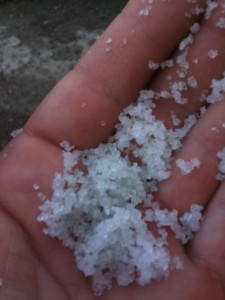 The spring period is a great period for making both organic and mineral fertilizers. From the list organic fertilizers you can use rotted compost, manure, chicken manure, etc. Those who adhere to natural vegetable growing and gardening apply these fertilizers. They are no worse than purchased fertilizers.
The spring period is a great period for making both organic and mineral fertilizers. From the list organic fertilizers you can use rotted compost, manure, chicken manure, etc. Those who adhere to natural vegetable growing and gardening apply these fertilizers. They are no worse than purchased fertilizers.
As a rule, organic fertilizers are applied in the fall after harvest. However, if this was not done, then it does not matter, you can fertilize in the spring. The soil application rates are as follows: 1 bucket of compost or rotted manure is applied per 1 square meter. You can also apply fertilizer based on peat. Such fertilizers improve the structure of the soil, loosening it, and saturate it with all the necessary nutrients. nutrients which persist in the soil for a very long time.
Fertilizing the garden and garden with organic fertilizers has several disadvantages:
- Organic fertilizers are expensive. In order to fertilize the entire site, you will have to pay a considerable amount of money. Therefore, never throw away or burn organic residues (dry grass, rotten vegetables and fruits, etc.), but put them separately in a compost heap. Good for those who keep animals or birds.
- Fresh manure, especially bird droppings can simply burn the roots of plants.
- There is a possibility of infection of plants with diseases. Again, this possibility arises if the manure is not well decomposed.
- Specific smell. This is definitely a shortcoming.
Video on how to make compost:
In addition to organic, you can make mineral fertilizers
. Fertilizing with mineral fertilizers is much easier. They are sold in any store in a concentrated form. You only need to be guided by certain dosages. Mineral fertilizers should be applied only immediately before digging.
The application rates for mineral fertilizers are as follows: on 10 square meters plot contribute: 300-350 grams nitrogen fertilizers, 200-250 grams phosphate fertilizers, 200-250 grams potash fertilizers. Mineral fertilizers do not improve the structure of the soil, but only saturate it with nutrients. Another disadvantage of such fertilizers is that they are quickly washed out of the soil.
Let's sum up a little. If you have the opportunity to fertilize your garden with organic matter, then fertilize it. If this is not possible, then enter mineral supplements.
When to fertilize in the spring?
A very important question regarding the timing of fertilization.
Let's start with mineral fertilizers. Mineral fertilizers are applied immediately before digging the soil. Fruit trees begin to fertilize when the snow completely melts and the frozen soil layer thaws. Usually, this period falls on the beginning-mid-April.
Organic fertilizers are applied 1.5-2 weeks before digging. Follow the listed norms, remember that an excess of fertilizers has a very bad effect on plants in the future.
How to fertilize trees in spring?
Trees in the spring are fertilized with the same fertilizers as vegetables. In order to fertilize the fruit tree well in spring period, it is necessary to pour it with a fertilizer solution. In particular, in the spring, the tree needs a large amount of nitrogen. Trees are fed as follows: at a distance of 0.5 meters from the trunk, a small groove is dug and 2-5 buckets of solution with top dressing are poured into this groove (1 tablespoon per 1 bucket of water).
The topic is immense, read also:
Which is better: hybrids or varieties?
Composting
The use of urea in the garden
Greenhouses for giving
Heating system for greenhouse
Preparing the greenhouse for winter
Fokine flat cutter
Egg shells as fertilizer
As practice shows, when using narrow-profile fertilizers for the garden, you can get about 70% of the increase in yield - both fruit and berry crops. Spring top dressing of the garden - growth and growth largely depend on it. appearance your plants, and, of course, the harvest itself.
1 Spring top dressing of the garden - fertilizers for the benefit of all
Now you can find on sale 2 types of fertilizers - simple and complex. They are suitable for all kinds of colors and garden plants. At the same time, complex ones already contain nitrogen, phosphorus and potassium - the necessary macronutrients. Together with them, microelements are also included in the combined composition. It is this set of necessary substances that your garden needs. Depending on the crop you grow, the required ratio of elements is also selected. In addition, the needs of different garden plants for feeding are also different, and therefore a lot depends on the balance of the elements. And do not forget that you do not have to chase quantity, but it is better to give preference to the quality of the fertilizer you have chosen.
As experts advise, it is preferable for any garden plants to purchase granular fertilizers. They contain all the nutrients your trees and shrubs need to grow and can be spread easily and evenly. For the most part fruit crops it matters what season of the year what percentage of the main elements will be. Thus, the need for nitrogen is greatest at the beginning of the growing season. If it is not enough, then the chlorophyll content will be reduced, which means that the bright green color of the plant will disappear, there will be fewer flowers and fruits, and the leaves may fall off. Therefore, it is very important that it is in the spring that your fertilizer contains the most nitrogen. The activity of flowering and fruit set depend to a greater extent on this element. With its deficiency, slow growth of shoots and insufficient formation of fruit buds are possible.
Those who have been gardening for more than a year know that top dressing in the spring is a mandatory process.
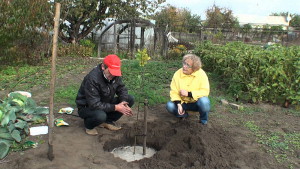
In summer, you also need to pamper the garden with fertilizers. At least once during the growing season. As in spring, in summer, the need for nitrogen in plants is very high, and only with the approach of the autumn season does it gradually decrease. Mature plants require more nutrition for more active growth. Do not forget about fertilizers in the fall - during this period, plants will need fertilizers with phosphorus-potassium components. This will help garden trees survive the winter, increase resistance to adverse factors. Well, it will facilitate a painless awakening in the spring.
2 Fertilizing plants in the spring in the garden is the responsibility of the gardener!
If you want to be a professional gardener, then every year you have to pick up fertilizer, garden tools and put in order in the spring the garden, waking up after hibernation. Getting down to such a necessary business, you must first clean the garden area itself - collect old leaves and dry plants, throw out garden debris. Then you should start feeding. It is better if you immediately prepare a fertilizer containing both nitrogen, potash, and phosphorus elements. Such care for the soil is simply necessary, because your plants get their nutrients from the soil. And after the winter there are very few of them left.
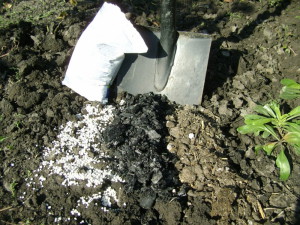
So, plants take nitrogen from the upper layers of the soil, where it accumulates. If it is not enough, then the tree or bush itself suffers. However, the plant can get many elements through the roots from the deep layers. But the root system of plants is developed in different ways. Under normal conditions, many nutrients are stored in the upper layer of the soil - humus from fruits and plants, and manure left by animals help in this. On your yard, you can fertilize the soil at the right time, giving trees and shrubs much-needed top dressing.

Already with the first spring rays of the sun, work begins in the garden. Plants must be prepared for the summer season, pruned, whitewashed trunks, treated for pests. Toward the end of March, right on the ice crust, the first fertilizers are applied. Their choice is huge and it can be difficult for novice gardeners to figure out what and when to make. The article will talk about proper feeding garden.
Mineral fertilizers for the garden
Phosphate fertilizers
The most common fertilizers containing phosphorus are superphosphate and phosphate rock.
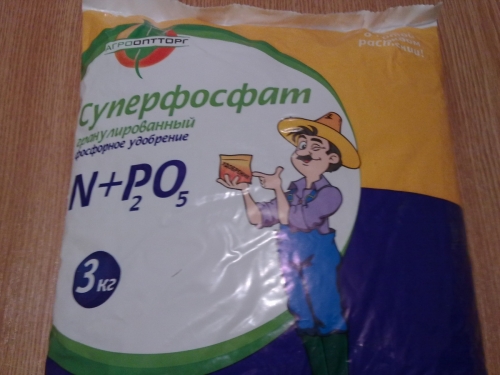
- Most summer residents choose superphosphate proven for decades in the form of granules, the phosphorus content of which is 48%. The time of its introduction into the soil depends on a particular crop, but still, it refers to autumn fertilizers, which contribute to the digging of the soil. This is due to the fact that phosphorus is needed for the formation of a good root system, which is so important for the successful wintering of plants.
- When applied in spring, it increases the amount flower buds, stimulates the formation of fruits.
Tip: phosphorus mineral fertilizers are not recommended to be applied simultaneously with lime, as it prevents the absorption of phosphorus by the roots.
- The fertilizer consumption is always indicated on the packaging, e.g. for double superphosphate it is 80-100 g/m2.
- For faster absorption of phosphorus by plants, it is recommended to do liquid top dressing. To do this, superphosphate is soaked in water for three days. Suitable for irrigation only liquid fertilizer, and the sediment can be poured into the compost heap.
potash fertilizers
- Potassium increases plant resistance to adverse external factors such as frost, drought or pests. It has been experimentally proved that potash fertilizers help to significantly reduce the degree of damage to plants by fungal diseases. But it is washed out quite quickly by rain, so it requires regular application to the soil or spraying.

- It is best to apply potash fertilizers along with phosphate fertilizers. But the combination with nitrogen is recommended to be excluded. This is due to the fact that potassium increases the amount of carbohydrates in the root system, which are so necessary for the formation of mycorrhiza, but nitrogen fertilizers begin to use them to form their organic compounds.
How to use potash fertilizers correctly:
- do not use when growing seedlings and during transplanting seedlings horticultural crops to a permanent place;
- for dry areas or for plant nutrition in greenhouses, it is better to use granular potassium sulfate, and for regions with frequent rains, potassium nitrate or potassium chloride is suitable;
- for acidic soils it will be better to use potassium chloride;
- they are compatible with almost all fertilizers;
- potash fertilizers reach the roots of the plant only after being dissolved with water, therefore, when applying, it is important to water them, but not too much. Otherwise, potassium will simply dissolve without having time to be absorbed by the roots;
- it is recommended to make them in small quantities, but often. This gives best result than with a double application of a larger dose per season;
- it is impossible to pour top dressing directly to the trunk of the plant, it is necessary to retreat 15-20 cm;
Nitrogen fertilizers for the garden
Popular nitrogen-containing top dressings that are suitable for fertilizing the garden in the spring:
- all types of nitrate (sodium, potassium, calcium, ammonium);
- urea, the second name is urea;
- azophoska.
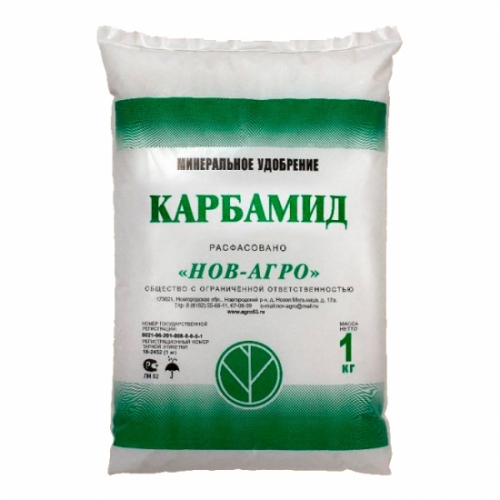
The highest percentage of nitrogen content is in ammonium nitrate, where it is 1/3 of the fertilizer. But when introducing it into the soil, one must take into account that it significantly acidifies the earth, therefore, it is recommended to add lime along with it.
How to use nitrogen fertilizers correctly:
- it is not recommended to apply at once with phosphorus-containing fertilizers (superphosphate or phosphate rock);
- for watering seedlings in spring or rooted seedlings in summer, it is best to use a liquid solution. To make it at home, you need to dilute 10 g of ammonium nitrate in 10 liters of water. Ammonia solution is not only watered under the root, but also sprayed with foliage. So, organic matter are quickly absorbed by plants;
- when applied dry, nitrogen fertilizers are recommended to be applied in spring or in the first half of summer, as they stimulate the growth of green mass. The exception is garden strawberry, she needs nitrogen at the end of summer in order to have time to grow more leaves by winter, which will protect her from winter frosts;
- in addition to top dressing, nitrogen-containing solutions can be used to combat plant diseases. For example, urea high content nitrogen (46%) is great for preventing the formation of scab or powdery mildew;
- for acidic soils, it is advisable to stop your choice on calcium or sodium nitrate. Although the nitrogen content in them does not exceed 15-16%, they perfectly stimulate plant growth without acidifying the soil;
- do not use nitrogen fertilizers in your garden, which contain chlorine-containing additives. They not only worsen the composition of the soil, but can also adversely affect the physiological development of many horticultural crops;
- under fruit trees and shrubs, nitrogen fertilizers are applied 2 times per season. First, in the spring, when the soil warms up and there is no chance of back frosts. And the second time - at the beginning of summer. If the soil is clayey, then a fertilizer such as ammonium sulfate can be applied until autumn. But be sure to dig into the ground, otherwise they quickly lose their useful properties;
- they must be introduced into the near-stem circle evenly. If the soil is dry and rain is not expected, then water. This will prevent burning the root system.
organic fertilizers
You can not only buy fertilizers for the garden, but also make them yourself.
Manure
- It is by far the most popular organic fertilizer in gardens and villages. Depending on whose it is (cow, horse), the dosage and method of its introduction into the soil depends. But anyway, use it in fresh it is impossible, since all the substances necessary for the plant are still in an indigestible form.
- When manure decays, decomposition processes begin in it, which form a large amount of gas that is poisonous to plants. In addition, there is a high risk of germination of weed seeds that have not had time to rot.
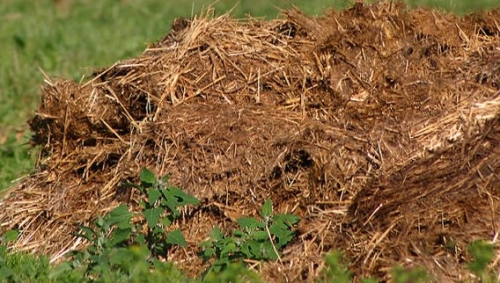
How to properly use manure as a fertilizer:
- before making, the manure must be re-rotted. To do this, they put it in a pile, sprinkle it with a layer of peat 20-25 cm on top and leave it for the whole summer. But this method is not suitable for horse manure it just burns out. It is recommended to leave it for a short time (no more than 2-3 weeks);
- for a higher concentration of fertilizer, mineral fertilizers can be added to the manure. So, for 100 kg of manure, 1-2 kg of superphosphate will be required. It is desirable to apply such top dressing to the soil once in 2 garden season. Consumption depends on the fertility of the land and averages 5 kg/m2.
Bird droppings as garden fertilizer
It is worth mentioning bird droppings separately, since in terms of the concentration of useful substances for plants, it significantly exceeds cow and horse manure.
- AT pure form it cannot be applied under plants even rotted, only under autumn or spring digging of the soil. On average, consumption per square meter of land should not exceed 250 g.
- It can be used for plant nutrition in summer only in liquid form. To do this, the container is filled with bird droppings by a third and filled with water. In order for the solution to mature, it must be stirred for 3-4 days. But even in this case, the concentration remains too high, therefore, before directly applying the solution under the plant, it should be diluted with water 4 times.
Compost
This is an excellent organic fertilizer, which practically does not require financial investments.
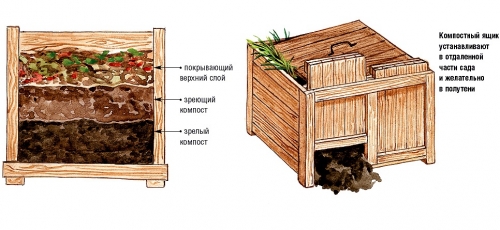
- They make it different ways, each of which has its own advantages and disadvantages. For example, many people dig a compost pit and put it there during the summer season. organic waste, cut grass and other unnecessary vegetation (except for weeds, which may eventually sprout). This method is the most economical, but to take the finished compost you have to turn the whole pile. And due to the lack of air access, the decay process is somewhat slower.
- The second way is compost bins. They are sold ready-made from plastic or they are made independently. The main thing is to provide a door below, through which it will be convenient to take compost in the future. To accelerate the maturation of the fertilizer, it is recommended to use special formulations, for example, Baikal. Also, the compost heap can be periodically watered and covered with a film. Some gardeners add bird droppings to their compost pile.
- To prevent bad smell from the ripening compost, each layer of new waste must be covered with peat.
- If crushed branches or sawdust were added to the compost, then in this case it will become suitable for soil fertilization no earlier than in 1-1.5 years.
Ash
Wood ash from hardwood trees is an excellent addition to mineral fertilizers. It is rich in phosphorus, potassium, calcium and a number of other trace elements that are easily absorbed by plants.

How to apply ash correctly:
- in a place protected from moisture, ash can be stored for years, while calcium, phosphorus and potassium will be preserved. But it is more convenient to apply it during the entire growing season directly from the stove;
- ashes are always poured into landing pit along with compost or rotted manure. The soil filled in this way for 3-4 years will give the plant useful trace elements, which means that it will no longer need additional top dressing;
- ash is scattered under young plants in early spring. Together with the melted snow, it will penetrate to the surface roots, and they receive nutrition already at zero temperature;
- ash is good because it contains a large amount of calcium, but there are no chlorine-containing substances.
Sapropel
- It is also a kind of organic fertilizer. Sapropel is deposits from the bottom of reservoirs, which rots together with silt and thereby accumulates useful microelements. It can be added to compost or mixed with mineral fertilizers when planting.
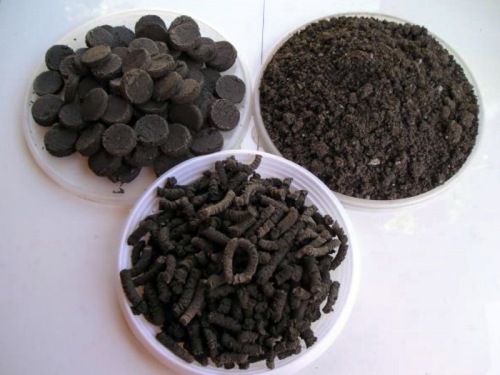
Variety of organic garden fertilizers
- "Darina"- this is a whole series of drugs, but they are all made on the basis of sapropel. They also added a complex of mineral fertilizers, such as nitrogen, humic acids, phosphorus, potassium. Significantly affects the increase in yield.
- EM- this is the name of the fertilizer, which stands for effective microorganisms. It is added to the compost, which significantly speeds up its preparation (1-2 months). Most effective when applied through composting in autumn. Suitable for poor soils and economical to use.
- TMAU- peat-mineral ammonia fertilizers. They are produced on the basis of peat, ammonia water, potassium chloride, superphosphate and a number of other trace elements. It is suitable for fertilizing all fruit and berry bushes and trees. For the season, it is enough to add 1 kg of the mixture to the near-stem circle of an adult plant.
- Herbal supplement. For this, beveled lawn grass, dandelion, nettle, plantain, mustard and wood lice. They fill a third of the container and fill it with water. In a few days, the fertilizer will be ready. It is suitable for all garden plants, but has an extremely unpleasant odor.

- Eggshell. Crushed eggshells are rich in calcium and help reduce soil acidity. It is recommended to use it for feeding sea buckthorn, cherries, plums, because it is these crops that are particularly sensitive to high acidity of the soil.
Homeopathic fertilizer "Healthy garden"
- This is a drug invented in St. Petersburg and has no analogues in the world. It is environmentally friendly, as it consists of refined sugar granules, which are structured under the influence of magnesium, potassium, sodium and even gold.

- Fertilizer healthy garden» cleans vegetable crops from nitrates, protects plants from pests and diseases. It is recommended for those who garden plot located near highways.
- On the "healthy garden" site, it is used during watering or spraying both young and adult plants. Since it is sold in the form of granules, you will need to make a solution yourself. To do this, 2 granules must be dissolved in 1 liter.
During the use of the drug:
- plants become more resistant to most diseases, including scab and powdery mildew;
- increases their resistance to drought;
- it is especially effective for apple trees, after applying the drug, the carrion decreases several times, due to the fact that the plants are not affected by aphids, apple codling moth, apple sawfly;
- the accumulation of various poisons by plants is reduced. Which can get into the soil along with fertilizers;
- Cut flowers last longer in water.
Complex fertilizers
Preparations specially designed for plants contain all the necessary trace elements in the right proportions. They are selected in such a way that everything is assimilated with maximum benefit and is environmentally friendly.
- "Giant"- granular fertilizer for all types vegetable crops. After making the soil is enriched for 3-4 years. Does not require dissolution in water. When planting cucumbers or tomatoes, add 1 tbsp. a spoonful of granules
- "Berry" - as the name implies, it is suitable for application under berry bushes. Strawberries and strawberries are especially fond of him, which are harmed by an excess of mineral fertilizer. It not only increases the yield, but also accelerates the ripening of berries. It must be applied in the spring for 1 tbsp. spoons under the bush and in the summer, again during the ripening of the crop. It also recommends using it for raspberries, honeysuckle, currants and other berry bushes.
- "Ideal" Sold in liquid form in 1.5 liters. bottles. This highly concentrated preparation is suitable for feeding all horticultural crops. It affects the increase in yield and the resistance of the plant to diseases and pests, for example, black leg and powdery mildew. It is also used for top dressing through the foliage, after diluting 50 ml of the solution in 10 liters of water. It is necessary to spray twice a season, spending 5 liters / m2.
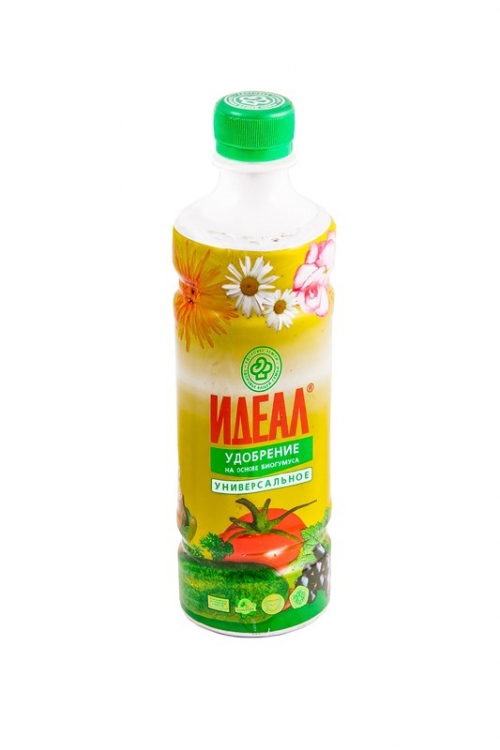
Mistakes not to make when fertilizing
- Organic fertilizers are not always exclusively beneficial. Its excessive application will lead to a decrease in the frost resistance of the plant, to slower growth and poorer fruit ripening. As a result, their keeping quality will also worsen.
- A large amount of mineral nitrogen-containing fertilizers will lead to the death of berry crops.
- If potash and phosphorus granular fertilizers are simply scattered over the soil surface, then they are not absorbed by the root system of the plant.
- Fertilizing without further watering also leads to plant diseases.
Spring top dressing of the garden - fertilizers for the benefit of everyone
Now you can find on sale 2 types of fertilizers - simple and complex. They are suitable for all kinds of flowers and garden plants. At the same time, complex ones already contain nitrogen, phosphorus and potassium - the necessary macronutrients. Together with them, microelements are also included in the combined composition. It is this set of necessary substances that your garden needs. Depending on the crop you grow, the required ratio of elements is also selected. In addition, the needs of different garden plants for feeding are also different, and therefore a lot depends on the balance of the elements. And do not forget that you do not have to chase quantity, but it is better to give preference to the quality of the fertilizer you have chosen.
- Garden plants with decorative leaves
- Spring plowing
- orchard
As experts advise, it is preferable for any garden plants to purchase granular fertilizers. They contain all the nutrients your trees and shrubs need to grow and can be spread easily and evenly. For most fruit and berry crops, it matters what season of the year what percentage of the main elements will be. Thus, the need for nitrogen is greatest at the beginning of the growing season. If it is not enough, then the chlorophyll content will be reduced, which means that the bright green color of the plant will disappear, there will be fewer flowers and fruits, and the leaves may fall off. Therefore, it is very important that it is in the spring that your fertilizer contains the most nitrogen. The activity of flowering and fruit set depend to a greater extent on this element. With its deficiency, slow growth of shoots and insufficient formation of fruit buds are possible.
Those who have been gardening for more than a year know that top dressing in the spring is a mandatory process.

In summer, you also need to pamper the garden with fertilizers. At least once during the growing season. As in spring, in summer, the need for nitrogen in plants is very high, and only with the approach of the autumn season does it gradually decrease. Mature plants require more nutrition for more active growth. Do not forget about fertilizers in the fall - during this period, plants will need fertilizers with phosphorus-potassium components. This will help garden trees survive the winter, increase resistance to adverse factors. Well, it will facilitate a painless awakening in the spring.
Fertilizing plants in the spring in the garden is the responsibility of the gardener!
If you want to be a professional gardener, then every year you will have to pick up fertilizers, garden tools and put in order in the spring a garden that has woken up after hibernation. Getting down to such a necessary business, you must first clean the garden area itself - collect old leaves and dry plants, throw out garden debris. Then you should start feeding. It is better if you immediately prepare a fertilizer containing both nitrogen, potash, and phosphorus elements. Such care for the soil is simply necessary, because your plants get their nutrients from the soil. And after the winter there are very few of them left.
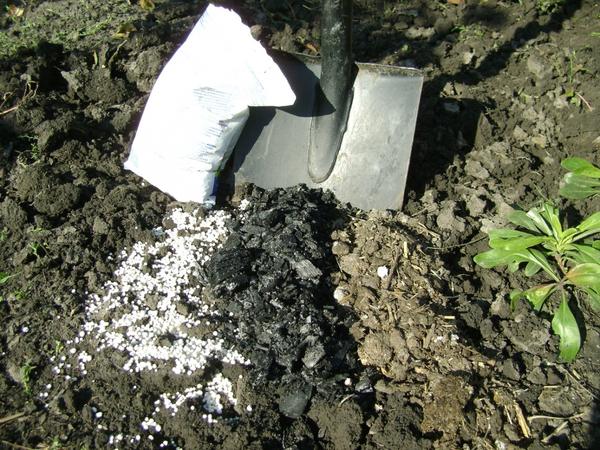
So, plants take nitrogen from the upper layers of the soil, where it accumulates. If it is not enough, then the tree or bush itself suffers. However, the plant can get many elements through the roots from the deep layers. But the root system of plants is developed in different ways. Under normal conditions, many nutrients are stored in the upper layer of the soil - humus from fruits and plants, and manure left by animals help in this. On your yard, you can fertilize the soil at the right time, giving trees and shrubs much-needed top dressing.
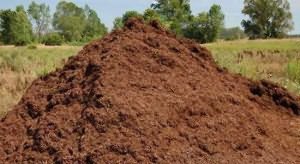
If the plants lack nutrients taken from the lower and upper layers of the soil, you can solve the imbalance problem yourself with the help of fertilizers.. If you feed the earth in time, then soil depletion can be avoided. You can buy a complex fertilizer for plants, focused on the spring. Usually, on the package with mineral fertilizers, the season is indicated by the corresponding marking.
So, you are ready to help your garden and have already purchased the necessary preparations. Now, the basic rules:
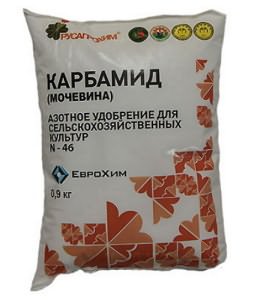
nasotke.ru
Spring feeding of fruit trees
Spring feeding of fruit trees and shrubs
Hello dear friends!
Fruit trees require quality nutrition all year round. The root system of perennial trees consumes biologically active compounds constantly, including during winter period. Fertilizers applied in autumn cannot always provide the necessary concentration and ratio of biologically active components throughout the growing season.
That is why it is necessary in the garden, both foliar and soil. At the same time, pruning should be carried out garden trees, whitewashing trunks, spraying to protect plants from harmful insects that can destroy the crop. So:
Garden pest control
Until the buds hatch, care should be taken to protect plants from aphids. After examining the trees, you can see ants crawling along the branches, and upon closer examination, you will see black dots next to the swelling buds, which are the laying of aphid eggs. When the first greenery appears, these insects will hatch from the eggs and begin to feed on succulent leaves, damaging the garden.
Bordeaux liquid
In order to prevent the spread of pests, experienced gardeners strongly recommend spraying trees and shrubs with Bordeaux liquid, which is a mixture of slaked lime and copper sulfate, at the very beginning of spring. This stage garden work must be carried out immediately after the snow melts and always before the cracking of the kidneys. Bordeaux mixture is a proven tool in the fight against dangerous garden pests which has not lost its relevance even today.
A solution of urea and copper sulfate
The second option for a tree treatment solution is a mixture of urea (urea) with blue vitriol. As a rule, insecticidal complexes containing these components are sold in specialized gardening stores and are designed for 8-10 liters of water. The combination of urea with copper sulphate kills fungal spores, egg clutches of many dangerous insects, including the flower beetle, and protects the plant from spring frosts, delaying the flowering period by 1-2 weeks.
The main thing during processing is to strictly observe the recommended dosages. The advantage of using such compounds is that in addition to the destruction of pests, the tool is foliar top dressing for plants. Urea, falling directly on the branches, buds and bark, nourishes the tree, which receives additional strength in the form of nitrogen compounds for awakening and active growth. In addition to fruit trees, currant bushes and gooseberry bushes should be treated with a solution.
Soil top dressing of garden trees
It is desirable that in trunk circle the soil was free of grass, as weeds have root system, which goes to great depths, and take away from the soil the nutrients necessary for the tree and future fruits.
To ensure oxygen access to the roots, the earth in the near-trunk circle should be dug up and loosened. After these events, a shallow furrow along the contour usually remains, into which they can choose to close up: organic or mineral top dressing. Then they are lightly sprinkled with earth. BUT regular watering and precipitation help to deliver active beneficial compounds deep into the earth, from where they are absorbed by the root system of the tree.
It is advisable to carry out intrasoil feeding of trees 15-20 days before flowering (early spring, March-April). During this period, trees require large amounts of nitrogen compounds. Fast-acting nitrogen-containing fertilizers are used: bird droppings are best suited from organic ones, and ammonium nitrate is best from mineral ones.
And remember that spring fertilizing fruit trees and shrubs, as well as treatment against pests - a guarantee of high-quality bountiful harvest your garden. Have a good season, dear gardeners! See you!
Site news for your email! Enter your Email
ayatskov1.ru
Feeding lilies - growing lush flowers in the garden
Why is it so important to spend time on spring feeding?
During the spring and summer, the bulbs of these beautiful flowers need to build up a green mass, "bring" the aerial part of the lily to flowering, complete this process and prepare for the new one. Without proper nutrition, a lily is unlikely to cope with such huge loads. Spring feeding will enhance not only the growth of the plant, but also its flowering. That is why the first top dressing should be carried out after planting lilies, as soon as the roots of the plant can absorb nutrients.
To do this, it is necessary that the soil warms up to at least +6 ° C. Most often, this temperature occurs in mid-May (in northern regions warmer weather may settle a little later). To accurately determine the timing of fertilization, look for lily seedlings, which should reach a minimum of 10 cm, the leaves of the plant should begin to move away from the stem. But it is not recommended to apply fertilizer earlier - the roots will not be ready.
Top dressing can harm the plant. A high concentration of mineral additives in the soil can adversely affect the flower: the plant will begin to develop more slowly, the roots and the aerial part will be sluggish, prone to disease.
When it comes to organic fertilizers, such as compost, it is worth remembering that weed seeds are often found in such additives. They grow much faster than lilies, as a result of such top dressing, it may turn out that the grown weed grass will begin to drown out the seedlings of flowers, will take light and nutrients from them. As a result, thorough and frequent weeding and removal of weeds is indispensable.
If the soil in your area is not tired of perennial plantings, there is a lot of humus in it, then the first few years after planting the lily bulbs, it is not necessary to feed the plants. But if the earth does not please with useful trace elements, has a poor composition, you can’t do without top dressing, or the plants will be weak.
How to work in the spring?
In order for the flowers to develop well and grow throughout the summer season, in the spring they need abundant nitrogen application to the soil. One of the fertilizer options during this period is the use of ammonium nitrate, which is applied at the rate of one spoon per square meter of soil. Ammonium nitrate can be replaced with nitroammophos.
From organic fertilizers, use a fermented solution of mullein diluted with water in a ratio of 1:10. It is undesirable to use fresh mullein because of its "aggressive" microflora, as a result of which lily bulbs can get sick and die. In the spring, you can feed the lilies with an ash solution: dissolve 200 g of sifted wood ash in 10 liters of water. You can either apply it along with watering, or add it little by little to the soil throughout the spring once a week.
You can also add manure humus or rotted compost to the soil where lily bulbs are planted. And it is best to use crumbly biohumus, which was formed as a result of the vital activity of earthworms. But in no case do not use fresh manure - the flower bulbs will rot immediately.
In summer, it is also very important to rationally fertilize. Experienced gardeners recommended for this purpose wood ash, which is applied during the summer season about 5 times. This fertilizer will positively affect the growth of the plant, thanks to which you can get larger flowers: if you work according to all the rules, the flowers will be lush, bright and large. In addition, summer top dressing will help lilies be more resistant to various diseases.
During the formation of buds, it is advisable to once again apply to the soil ammonium nitrate, as well as process all the vegetative parts of the flower suitable formulations from pests, which will make the lilies even healthier. Next stage summer top dressing comes in mid-July. You need to add a substrate of double superphosphate to the soil and Kalimagnesia. This top dressing will help strengthen the aerial part of the plant and make the flowers more vibrant. This will be especially noticeable when you plant lilies with pink or bright red flowers.
When carrying out work during the flowering of lilies, it is advisable to use fertilizers in liquid form. Granular formulations will be ineffective - there is too little time for complete dissolution in the soil and absorption by the plant. It is also more effective to fertilize after abundant watering.
nasotke.ru
Fertilizing the garden and garden in spring
In the spring, it is time for active work for summer residents, gardeners and gardeners. In order to get a good harvest in the fall, you need to work hard in the spring. In particular, in the spring it is very important to choose the right fertilizers and apply them to the soil. With all this, it is necessary to take into account the needs of the crops that will be grown on the site.
Fertilizing the garden and garden in spring- This is a very important preparatory stage before planting plants. Many novice gardeners and gardeners are wondering how to feed the garden in the spring. In this article we will try to answer this question.
The need for fertilization in the spring is due to the fact that the soil is depleted from year to year, and it needs to restore the structure and availability of nutrients.
What to fertilize?
The spring period is a great period for making both organic and mineral fertilizers. From the list of organic fertilizers, you can use rotted compost, manure, chicken manure, etc. Those who adhere to natural vegetable growing and gardening apply these fertilizers. They are no worse than purchased fertilizers.
As a rule, organic fertilizers are applied in the fall after harvest. However, if this was not done, then it does not matter, you can fertilize in the spring. The soil application rates are as follows: 1 bucket of compost or rotted manure is applied per 1 square meter. You can also apply fertilizer based on peat. Such fertilizers improve the structure of the soil, loosening it, and saturate it with all the necessary nutrients that remain in the soil for a very long period of time.
Fertilizing the garden and garden with organic fertilizers has several disadvantages:
- Organic fertilizers are expensive. In order to fertilize the entire site, you will have to pay a considerable amount of money. Therefore, never throw away or burn organic residues (dry grass, rotten vegetables and fruits, etc.), but put them separately in a compost heap. Good for those who keep animals or birds.
- Fresh manure, and especially bird droppings, can simply burn the roots of plants.
- There is a possibility of infection of plants with diseases. Again, this possibility arises if the manure is not well decomposed.
- Specific smell. This is definitely a shortcoming.
Video on how to make compost: In addition to organic, you can make mineral fertilizers. Fertilizing with mineral fertilizers is much easier. They are sold in any store in a concentrated form. You only need to be guided by certain dosages. Mineral fertilizers should be applied only immediately before digging.
The application rates for mineral fertilizers are as follows: 300-350 grams of nitrogen fertilizers, 200-250 grams of phosphate fertilizers, 200-250 grams of potash fertilizers are applied per 10 square meters of land. Mineral fertilizers do not improve the structure of the soil, but only saturate it with nutrients. Another disadvantage of such fertilizers is that they are quickly washed out of the soil.
Let's sum up a little. If you have the opportunity to fertilize your garden with organic matter, then fertilize it. If this is not possible, then apply mineral supplements.
When to fertilize in the spring?
A very important question regarding the timing of fertilization.
Let's start with mineral fertilizers. Mineral fertilizers are applied immediately before digging the soil. Fruit trees begin to fertilize when the snow completely melts and the frozen soil layer thaws. Usually, this period falls on the beginning-mid-April.
Organic fertilizers are applied 1.5-2 weeks before digging. Follow the listed norms, remember that an excess of fertilizers has a very bad effect on plants in the future.
How to fertilize trees in spring?
Trees in the spring are fertilized with the same fertilizers as vegetables. In order to fertilize a fruit tree well in the spring, it is necessary to water it with a fertilizer solution. In particular, in the spring, the tree needs a large amount of nitrogen. Trees are fed as follows: at a distance of 0.5 meters from the trunk, a small groove is dug and 2-5 buckets of solution with top dressing are poured into this groove (1 tablespoon per 1 bucket of water).
The problem of the need for seasonal fertilization in the spring is well known to every gardener or florist. At this time, plants are especially in need of nutrients and elements, because the growing season begins. The question arises: how to properly fertilize and how to fertilize the land if there is no manure.
When is the best time to fertilize the soil in spring?
That spring is considered best time for fertilization different kind, is a fact proven by both science and practice. It is in spring that the active growth of plants begins. The rate of green mass recruitment, bud formation and, ultimately, quantitative and quality characteristics future harvest.
One way to apply fertilizer to the soil is at the time of soil preparation. . For example, manure or compost. If in its structure the soil in the country or personal plot is light, it is recommended to add mineral complexes to it. They are indicated for early application and in areas flooded melt waters. If you apply mineral fertilizer in the autumn months, then most of the micro and macro elements will be washed out by the flood. The advantage of this method is the distribution of useful substances over the entire depth of digging or plowing.
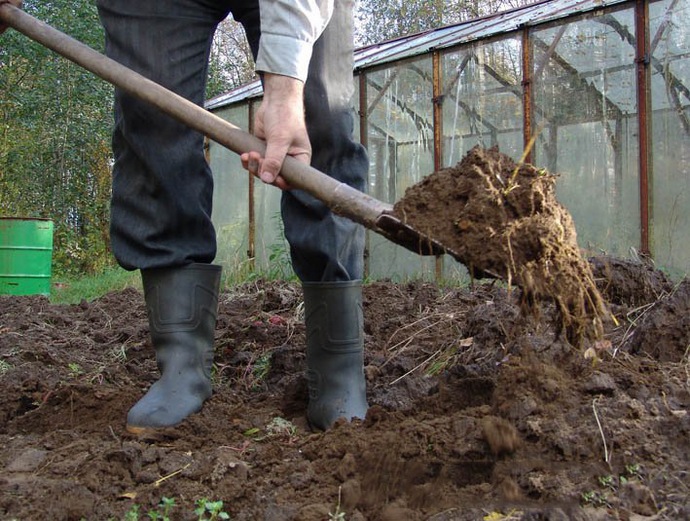
Another way to apply any fertilizer in the spring is shortly before or just before planting. For this, the funds are placed in dug holes or spilled with a solution of the beds after planting the seeds.
Some gardeners do not wait for the snow to melt and the soil to thaw, spreading fertilizer directly on the snow cover over the surface. But at the same time there is a risk that substances will be carried away by melt water. The exception is fruit trees in the garden, which have an extensive root system. Even if fertilizers are transferred a couple of meters, most likely, some of them will "get to their intended purpose." For this, fertilizers are distributed over the snow cover around the tree trunk.
In order not to get confused when and how much fertilizer was applied, you can make a plan on paper, marking each top dressing. So every culture will get required amount both mineral and organic matter.
How to fertilize the soil with ash (video)
How to properly fertilize the land with manure
But when used incorrectly, it does more harm than good. It is dangerous to introduce fresh manure, especially mixed with straw. It may contain weed seeds and even pathogens in plants. If you feed vegetables - tomatoes or cucumbers - with fresh manure, then for about a month they will experience a nitrogen deficiency, which will adversely affect the growth rate and yield. Therefore, the fertilizer must be rotted.
Most often, fertilization is carried out at the stage of preparing the soil for planting. In this case, the soil is dug up and at the same time fertilizers are applied (for example, manure or compost). He will highlight needed by plants items for several years. But the value of fertilizer is reduced if left on the surface of the earth, because most of the substances from the composition will evaporate into the air.

When the manure is spread over the surface of the soil with a pitchfork, the fertilizer should be planted into the ground as soon as possible. But the depth should not be too great to make it easier for plants to get food. Optimal distance embedding - the height of the shovel blade. That's why ordinary digging will be enough. Moreover, if you re-dig up the earth after 7-10 days, then the rate of decomposition of manure will increase, and it will release more useful substances in the coming season.
Another method of using manure is in the form of slurry. She is watering the plantings. For proper cooking it is necessary that the slurry ferment for at least 2 weeks. After that, it is diluted by half with water. To enhance the effect, you can add superphosphate fertilizer.

What fertilizers do houseplants need in spring
Most indoor plants, as with garden or garden crops, vegetation begins, that is, active growth. The exception is some species that prefer to develop and bloom in winter: for example, Decembrists and cyclamens. Their feeding, on the contrary, must be reduced.
Both organic and mineral substances are useful for the inhabitants of the window sill. Therefore, it is possible to alternate the application different types fertilizer, based on the needs of certain species.
So, decorative leafy plants need a lot of nitrogen, and flowering plants need phosphorus. But, for example, hibiscus does not tolerate phosphorus, because in its homeland this substance is contained in the soil in minimum quantity. Orchids and their closest relatives love minerals diluted in high concentrations. Therefore, before you start feeding, you need to read about the features of the species.
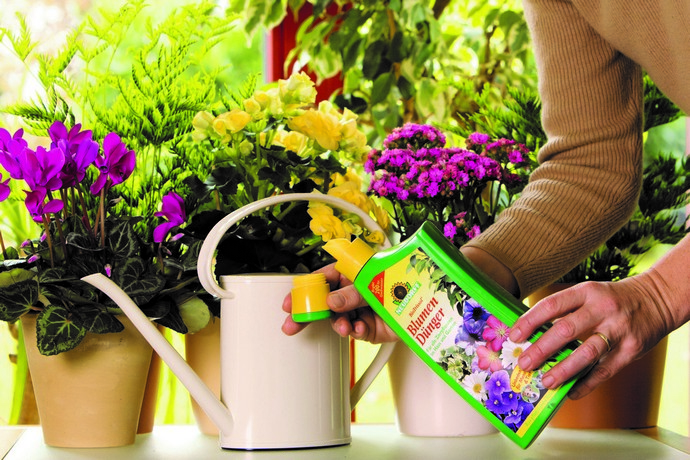
The easiest option is to buy ready-made fertilizer in the store. The assortment allows you to choose a remedy for each flower.
Many indoor plant lovers enjoy " folk remedies", and their experience shows that the result of such dressings is no worse than from purchased ones. chemicals. The use of ground banana peel has become popular. It will be useful to use granulated sugar rich in glucose, or crushed eggshell . You can buy succinic acid at the pharmacy, which increases the resistance of plants to diseases and stimulates growth.
Soil fertilizer varieties (video)
How can you fertilize the land if there is no manure
It is not always possible to use manure for fertilizer. How do plants get the necessary substances? There are other means that can give planting the right nutrition.
Alternative types of organic fertilizers
Although manure is the most popular organic animal fertilizer, several other products are of equal value and can be used in growing plants. For example, this is:
- Compost, which is rotted plant or animal (chicken manure) remains. In practice, it is most often made from weeds, household waste, such as potato peelings, hay, old fruits, etc. The compost is kept for at least 3 months. This time is necessary for microorganisms to process raw materials into nutritious humus. The introduction of such a fertilizer significantly increases the fertility of the soil and improves its structure.
- siderates- green manure. These are plants that are sown for the purpose of subsequent incorporation into the soil. Rotting in the soil, they release substances and elements for further nutrition of plantings. Green manure plants include legumes, cereals and cruciferous plants. The use of mustard is popular.
- Adding to the soil peat, ash, sawdust, silt also improves soil fertility.
The basic principle of action of all these universal types of organic fertilizers is the decomposition in the soil into substances suitable for easy assimilation by plants. Their undoubted advantage is the absence of chemicals.
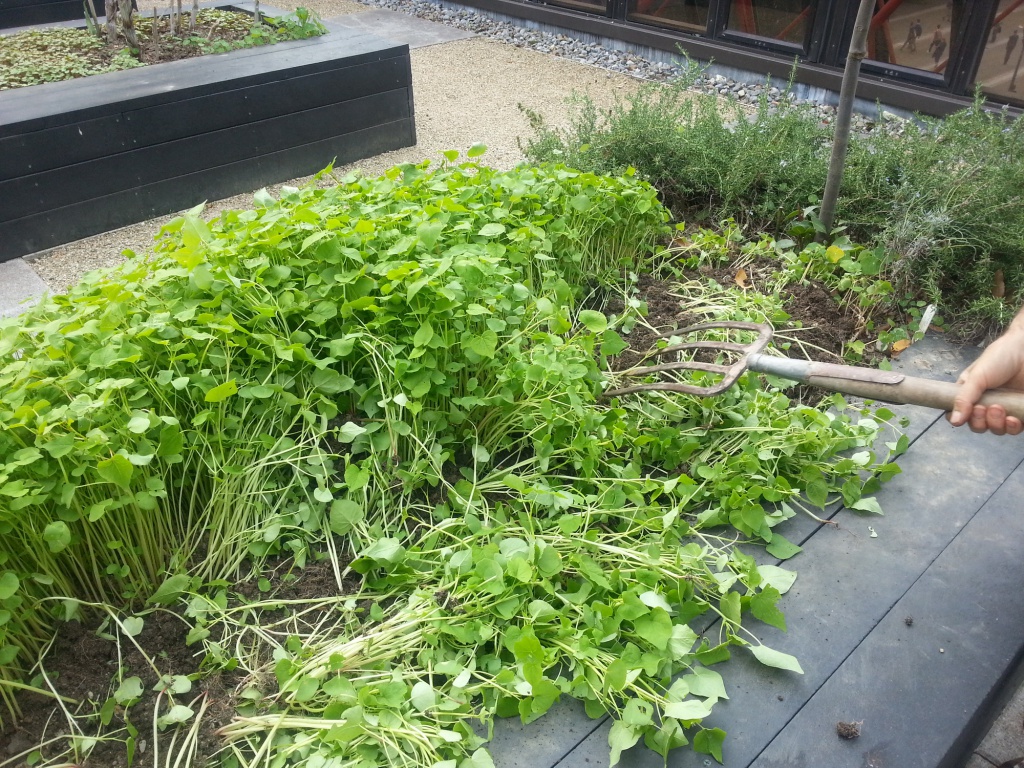
What mineral fertilizers to apply to the soil in spring
All mineral fertilizers can be divided into simple, which include one main element, and complex. It is necessary to choose a product for spring use depending on the crop for which it is used. will be used:
- nitrogen fertilizers contribute to the set of green mass. They are useful for greens, cabbage, etc. These are urea, ammonium nitrate.
- potash fertilizers stimulate the growth of the root system, so they need to fertilize the soil intended for growing root crops. The most effective is potassium chloride (contains 60% of this element).
- Phosphorus affects the taste, weight, size and number of fruits. They need to fertilize berry crops, tomatoes, legumes, etc. For example, superphosphate is such a fertilizer.
It is important to remember that an excess of elements is also harmful to plants. Therefore, you need to follow the dosages indicated on the fertilizer packaging.
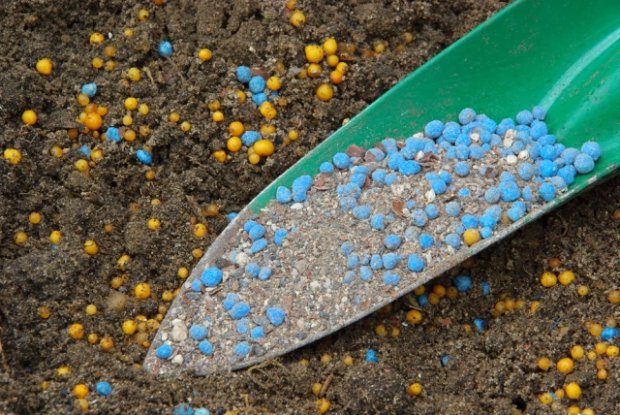
Complex fertilizers for spring feeding of horticultural and horticultural crops
To complex fertilizers include nitroammophoska, diammophos, potassium nitrate and others. They contain several elements at once in different percentages in the composition. They must be selected individually. So, potassium nitrate is dominated by potassium - 46%, and nitrogen - only 13%. This fertilizer is ideal for potatoes or root crops.
The use of complex mineral fertilizers has important advantages. Firstly, there is no need to independently calculate the percentage of individual elements for feeding. Secondly, their use in practice is not difficult. Yes, and the yield is significantly increased. But when working with mineral fertilizers, safety measures must be observed: many of them are toxic and even explosive.
Urea: fertilizing the soil in spring (video)
When choosing fertilizers, you need to know what the needs and plants are and focus on them. If you provide them with all the necessary substances, you can wait abundant flowering or harvest.
And some secrets...
Have you ever experienced unbearable joint pain? And you know firsthand what it is:
- inability to move easily and comfortably;
- discomfort when going up and down stairs;
- unpleasant crunch, clicking not of their own free will;
- pain during or after exercise;
- inflammation in the joints and swelling;
- causeless and sometimes unbearable aching pain in the joints ...
Now answer the question: does it suit you? Can such pain be endured? And how much money have you already "leaked" for ineffective treatment? That's right - it's time to end this! Do you agree? That is why we decided to publish an exclusive interview with Professor Dikul
Attention, only TODAY!

